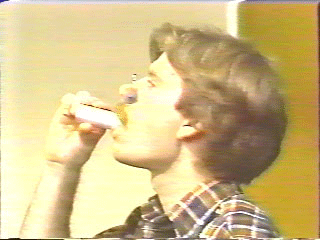
Explain to the subject how the forced
expiratory maneuver is performed:
a. Hold the spirometer tube near a shoulder so that it will be close by
when needed.
b. Take the deepest possible breath after breathing in and out normally
for several seconds.
c. Bring the spirometer tube to the mouth and place it on top of the
tongue between the teeth. Put the mouth firmly around the mouthpiece, making
sure not to purse the lips as if blowing a musical instrument. (Instruct the
subject not to inhale from the mouthpiece unless information on inspiration as
well as expiration is to be recorded.)

d. Keep the chin slightly elevated and make sure that the tongue is out
of the mouthpiece.
e. Without further hesitation, BLAST into the mouthpiece of the spirometer as hard, fast and completely as possible.
f. Keep blowing as long as you can or until you are told to stop.
Always demonstrate for the subject the
proper technique using a mouthpiece.
Perform last minute equipment preparations if applicable:
a. Place the recorder pen in the appropriate position on the chart paper.
b. Start the paper moving at least one second before the subject blows
into the mouthpiece.
Coach the subject
a. Instruct the subject: "Whenever
you are ready, take the deepest possible breath, place your mouth firmly around
the mouthpiece, and without further hesitation, blow into the spirometer as
hard, fast, and completely as possible." Watch the subject inhale fully, place
the mouthpiece, and BLAST out the air. Most important, coach as deep of an
inhalation as possible.
b. Actively and forcefully coach the
subject as he/she performs the maneuver (Enthusiastically coach, "BLAST the air
out, blow, keep blowing, keep blowing!"). (Studies have shown that active
coaching during both inspiration and expiration help the subject to give a
maximal effort.)
c. Keep coaching them to continue to
exhale until the point at which the tracing becomes almost flat -- an obvious
plateau in the volume-time curve. Since the end of test is hard for the
technician to determine during the maneuver, tell the subject to blow as long as
he/she can. After each maneuver let him/her relax for a few minutes.
d. It is important the you not only monitor the curve for a plateau but
also observe the subject for positioning of the mouthpiece, a deep inhalation,
and a maximal effort. Some subjects may become "light-headed" and you may need
to assist them into a chair if the test is done in the standing position.
When testing subject in the standing position, it is a good idea to place a
chair, without rollers, behind the subject.
OSHA Cotton Dust Standard Definition of Plateau: less than 25 ml volume
change in 0.5 seconds (OSHA Cotton Dust Standard). This is hard to visualize and
requires that the technician become familiar with this degree of change. In
addition, one study has shown that strictly following the 25 ml in 0.5 seconds
criterion results in premature termination of the FVC maneuver and
correspondingly lower FVCs.
ATS 2005
Definition of Plateau: The American Thoracic Society, defines the end of
the test as: A plateau in the volume-time curve, as defined by no change in
volume (30 ml) for at least 1 second, and a reasonable expiratory time (at least
6-secnds in adults). In a normal young subject, the expiration would usually be
completed in less than 6-seconds. In an obstructed or older healthy subject, a
longer expiratory time is usually required to reach a plateau (> 15 seconds).
However, multiple prolonged exhalations (> 15-seconds) are seldom justified.
Check the acceptability of each tracing before continuing the testing.
Spirogram results are used to detect possible conditions that affect the
subject's ability to exhale as fully and forcefully as possible. The results are
compared either to the subject's previous spirometry results if they are
available or to established tables of results that would be expected for a
person with his/her characteristics (e.g., sex, age, height, etc.). (See
Chapter 6 - Comparing Observed and Predicted Normal Values and in
Chapter
7 - Comparing Changes in Follow-Up Spirograms). If inaccurate results
are obtained, the information from the comparisons will not be correct, creating
the potential for not detecting serious lung diseases, or, diagnosing disease
where none exists. Therefore, the goal of each testing session is to obtain
acceptable maneuvers and a repeatable test.
Question - 17 (Sample Question)